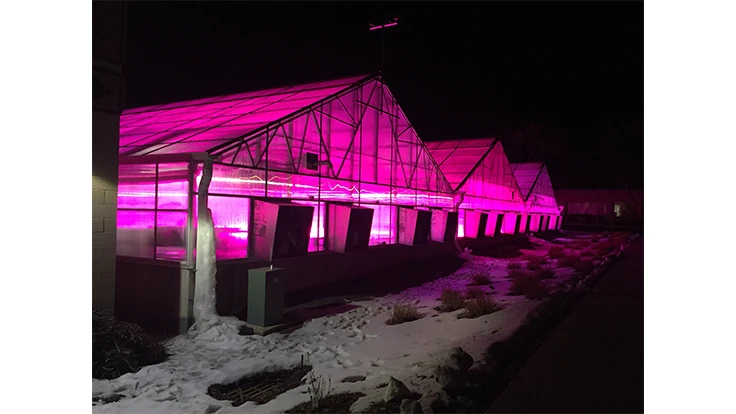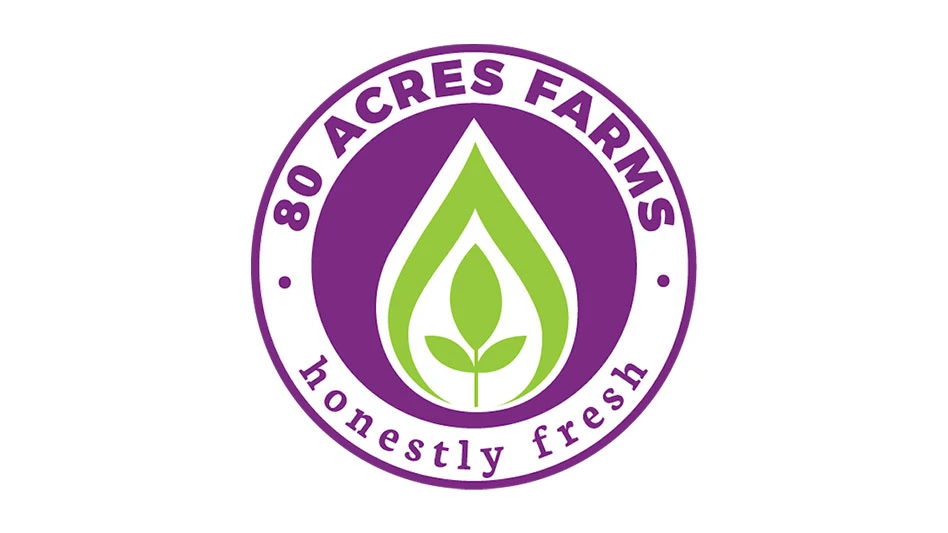
This past Jan. 16-18, the advantages, challenges and opportunities of LED lighting dominated the conversation at the LED Lighting Research Summit in Fort Collins, Colorado. The event, a collaboration between Colorado State University (CSU) and the horticulture LED lighting group from Philips Lighting, brought together growers, researchers, academics and other interested parties for two and a half days of focused discussions about LEDs in a horticultural setting. Editor Karen Varga of Greenhouse Management and Produce Grower was there to take it all in.
Before opening the floor to the researchers who would be presenting their findings on Tuesday and Wednesday, attendees had the opportunity to mingle and enjoy a reception and tour in the ideal place to be when snow is on the ground — a warm greenhouse. In 2016, CSU completed the greenhouse for its new Horticulture Center, an approximately 20,000 square foot Nexus structure with Philips Lighting toplighting, Wadsworth Controls (a Colorado-based company) control systems, Modine heaters and American Coolair fans. To read more about the collaborative partnership with Philips Lighting that enabled CSU to build this state-of-the-art facility and an educational program, click here.
At the greenhouse, attendees saw the hydroponic hops research conducted by Dr. Bill Bauerle, a foray into the opportunities that having a year-round, locally grown wet hops supply would give local craft brewers. According to Bauerle’s presentation the following day, 75 percent of the wet hops in the U.S. come from Washington, and are only available for a very short period of time. Craft brewers in Colorado are willing to pay a premium for a locally grown, year-round supply of wet hops. At the time of our visit, Bauerle had already grown four crops, selling the harvest to Colorado brewers who produced beers like the “Dr. Bill,” a nod to the researcher. We’ll be looking more at this topic later in the year. Other research that was on display included projects that looked at the effects of light on seedlings, flowering and other aspects, in both ornamental and vegetable crops.
During the opening remarks given by Ron DeKok, business development director of Philips Lighting, highlighted the fact that lighting is “one of the last unknowns in growing.” Much research has been done on other factors like nutrition and water, but there is still a need for more lighting research to maximize its potential. Dr. Steven Newman, greenhouse crops extension specialist and professor of floriculture at CSU, gave attendees both a welcome to the campus, and an overview of the evolution from CSU’s first greenhouse carnation research to today’s hops, flower and produce research.

Here are some of the takeaways from the research presented at the summit:
Wim van Ieperen, Wageningen University. “Effect of (LED) light on plants with emphasis on water relations.” Van Ieperen and his colleagues concluded that light quality does influence plant water relations in multiple ways, and impacts the productivity and quality of the crops. This study looked at cucumber and tomato plants.
Erik Runkle, Michigan State University. “LEDs and Photoperiodic Lighting.” Runkle started his research with photoperiodic lighting with LEDs in 2010 using 10 of the most common short and long day crops. Aside from sharing the results of some of these projects, Runkle also provided attendees with information on available lighting resources. Runkle, along with vertical farming expert Dr. Toyoki Kozai and Kazuhiro Fujiwara, edited “LED Lighting for Urban Agriculture,” a 450-page, 32-chapter book about the use of LEDs “for the commercial production of horticultural crops in plant factories and greenhouses with controlled environments.” It’s available for purchase in digital and print formats on Amazon.
Ricardo Hernandez, North Carolina State University. “Supplemental LED lighting as a potential alternative to chemical plant growth regulators in ornamental plug production.” In this research, they applied types and amounts of light (varying spectra of LEDs, HPS or none), with or without PGRs to investigate the effect on selected dianthus, geranium and petunia varieties. Among the conclusions, they found that regardless of the cultivar, plants that were given LED light were more compact than their counterparts in the control and PGR treatments. They found that LEDs can be a “potential alternative to chemical PGRs” for these crops.
Paul Karlovich, C. Raker & Sons. “Studies on LED sole-source production of ornamental plugs.” Karlovich’s main goals were to use LEDs to improve rooting and growth of ornamental plugs in a growth chamber at Raker, a wholesale plug and liner grower in Michigan. While his research is ongoing, he noted improvements in several areas, including a five percent improvement in rooting in Maverick Red geraniums and nearly 30 percent in tuberous begonias, and faster growth in gerbera and tuberous begonias. However, Karlovich concluded that he has the potential to improve the growing conditions even more, mentioning the need to do more research into optimum temperatures, light quality and quantity, and humidity to truly optimize his growth chamber production system.
Travis Higginbotham, Battlefield Farms. “Sole-source LED Lighting Tissue Culture Acclimation.” Higginbotham began his research with LEDs to find a solution to the issues they were having at Battlefield with rooting stage three tissue culture during the hottest months of the year, July and August. Despite some initial scorch, the LED trials were successful, and he moved on to trial pansies, a crop with similar issues. Higginbotham said that one advantage of the rooting consistency they achieved was that it cut out some of the guesswork and more reliably schedule in vacation time for growers. The next research project he’s working on is the use of UV/UVC radiation for the delay and deactivation of Botrytis.
Read more about Karlovich and Higginbotham’s initial research in this article from Greenhouse Management’s July 2016 issue here.
Bruce Bugbee, Utah State University. “Six considerations for determining the value of LEDs in commercial greenhouse applications.” Bugbee’s presentation took a critical look at the situations when it makes sense to use LED lighting – and when it doesn’t. Among the six considerations, he discussed the time to recover the initial investment into LEDs, maintenance costs and spectral effects on plant size and shape. While there were advantages to both HPS and LED lighting, it’s important for growers to take a hard look at what they’re hoping to achieve to make the right lighting decision.
Greenhouse and plant photos: Karen E. Varga
Group photo courtesy of Philips Lighting
Latest from Produce Grower
- The Growth Industry Episode 4: How federal budget cuts are affecting horticulture nonprofits
- U.S. indoor tomato growers support renegotiation of suspension agreement
- CEA Summit East 2025 returns to Virginia this September
- The Growth Industry Episode 3: Across the Pond with Neville Stein
- Southern Garden Tour sets 2025 dates for trial garden open houses
- IUNU secures $20 million to accelerate growth in AI-driven greenhouse technology
- Find out what's in FMI's Power of Produce 2025 report
- Fresh Express announces rebrand, launches 'Express Yourself' campaign






